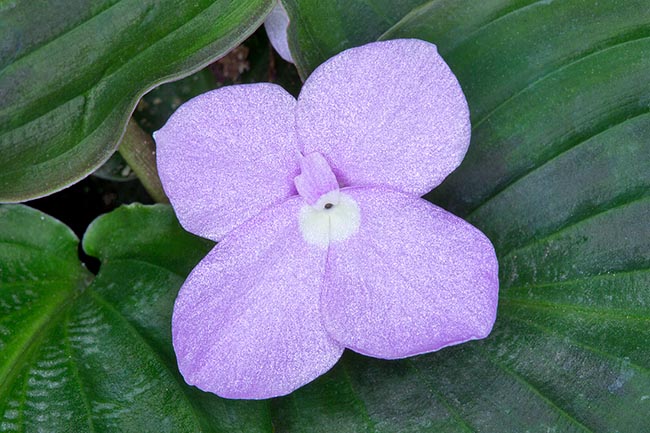Family : Zingiberaceae

Text © Pietro Puccio

English translation by Mario Beltramini

Little known, Kaempferia elegans is a rhizomatous and deciduous perennial herbaceous species of South-East Asia that may have a horticultural future. Varieties with very decorative ground cover leaves and 4-5 singly flowers © Giuseppe Mazza
The species is native to Borneo, China (Sichuan), Myanmar, Thailand and Vietnam where it grows in the underwood of the forests at low and medium altitudes.
The genus is honoured to the German physician and naturalist Engelbert Kaempfer (1651-1716); the specific name is the Latin adjective “elegans, -antis” = elegant, with obvious reference.
Common names: green ripple peacock ginger, purple-flowered resurrection lily (English); zi hua shan nai (Chinese); kencur (Malay); violeta-asiática, lírio-da-ressurreição (Portuguese-Brazil); ngải chúa (Vietnamese).
The Kaempferia elegans (Wall.) Baker (1890) is a deciduous perennial herbaceous species, up to about 20 cm tall, with small fleshy rhizome that in spring produces 2-4 basal simple leaves, on a 3-12 cm long, pubescent grooved petiole, elliptic to oblong with pointed apex and entire margin, 10-15 cm long and 5-8 cm broad, of glossy dark green colour above, paler below, slightly plicate. The inflorescence is an erect terminal spike, about 10 cm long, with oblong lanceolate green bracts, bearing 4-5 flowers that open in succession. Tubular 2,5 cm long calyx, tubular 5-7 cm long corolla, with 3 white lanceolate lobes 1,7-2 cm long, petaloid lateral staminodia of pale purple colour, obovate, 1,2 cm long, labellum incised almost up to the base in 2 obovate lobes, 1,5-2,5 cm long, of the same colour as the staminodia with a white spot at the base.
The fruit is a capsule containing numerous ellipsoid seeds provided of aril (involucre that in some species wraps totally or partially the seed). It reproduces by seed, in organic draining loam maintained humid at the temperature of 24-26 °C, but usually and easily by division. Relatively little cultivated species in respect to its varieties with spotted leaves, particularly ornamental, used as ground cover for its contained dimensions in the shaded or semi-shaded gardens, in the tropical and subtropical climates as well as in the temperate ones, as it goes at rest in the winter months, where at level of rhizome it may bear temperatures, provided well mulched, up to about -8 °C for a short period.
It requires draining soils, preferably sandy, rich of organic substance, maintained humid during the vegetative period. Is cultivable also in pot for the decoration of little luminous inner spaces.
Synonyms: Monolophus elegans Wall. (1830); Kaempferia crawfurdia Wall. ex Horan. (1862); Kaempferia atrovirens N.E.Br. (1886).
